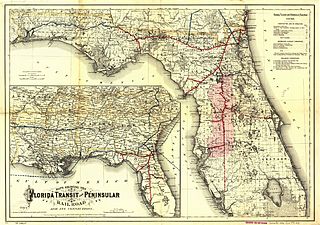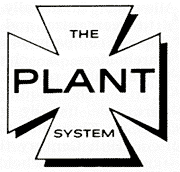
Baldwin is a town in Duval County, Florida, United States. When the majority of communities in Duval County were consolidated with the city of Jacksonville in 1968, Baldwin, along with Jacksonville Beach, Atlantic Beach and Neptune Beach, remained partly independent. Like the other towns, it maintains its own municipal government, but its residents vote in the Jacksonville mayoral election and vote for the Jacksonville City Council; unlike the others, Baldwin no longer supports its own police force. The population was 1,396 at the 2020 census.

The South Florida Railroad was a railroad from Sanford, Florida, to Tampa, Florida, becoming part of the Plant System in 1893 and the Atlantic Coast Line Railroad in 1902. It served as the southernmost segment of the Atlantic Coast Line's main line. The line remains in service today and is now part of the Central Florida Rail Corridor in the Orlando metro area. The rest of the line remains under the ownership of CSX Transportation as part of their A Line.

The Florida Central and Peninsular Railroad was the final name of a system of railroads throughout Florida, becoming part of the Seaboard Air Line Railway in 1900. The system, including some of the first railroads in Florida, stretched from Jacksonville west through Tallahassee and south to Tampa. Much of the FC&P network is still in service under the ownership of CSX Transportation.

The Plant System, named after its owner, Henry B. Plant, was a system of railroads and steamboats in the U.S. South, taken over by the Atlantic Coast Line Railroad in 1902. The original line of the system was the Savannah, Florida and Western Railway, running across southern Georgia. The Plant Investment Company was formed in 1882 to lease and buy other railroads and expand the system. Other major lines incorporated into the system include the Savannah and Charleston Railroad and the Brunswick and Western Railroad.

Tallahassee station, also known as the Jacksonville, Pensacola and Mobile Railroad Company Freight Depot, is a historic train station in Tallahassee, Florida. It was built in 1858 and was served by various railways until 2005, when Amtrak suspended service due to Hurricane Katrina. It was added to the National Register of Historic Places in 1997.
The Gulf Wind was a streamlined passenger train inaugurated on July 31, 1949, as a joint operation by the Louisville and Nashville Railroad and the Seaboard Air Line Railroad. The Gulf Wind replaced the heavyweight New Orleans - Florida Express on this routing. The Gulf Wind was a limited stops train and offered amenities such as dining cars and Pullman service. The train left Jacksonville at night and arrived in New Orleans in the evening, as the Express had done.
The Florida Railroad was the first railroad to connect the east and west coasts of Florida, running from Fernandina to Cedar Key. The line later became part of the Seaboard Air Line Railroad, and, where still in use, is operated by CSX Transportation and the First Coast Railroad. The highway corridor of SR 24, US 301, and SR A1A/SR 200 closely parallels the former Florida Railroad.

The Pensacola and Atlantic Railroad (P&A) was a company incorporated by an act of the Florida Legislature on March 4, 1881, to run from Pensacola to the Apalachicola River near Chattahoochee, a distance of about 160 miles (260 km). No railroad had ever been built across the sparsely populated panhandle of Florida, which left Pensacola isolated from the rest of the state. William D. Chipley and Frederick R. De Funiak, both of whom are commemorated in the names of towns later built along the P&A line, were among the founding officers of the railroad company.
The Jacksonville & Southwestern Railroad (J&SW) was a railroad that served Florida from 1899 to 1904. It was purchased by the Atlantic Coast Line Railroad in 1904. The Atlantic Coast Line would extend the line further west and it would become their Jacksonville—Wilcox Line. Some of the original right-of-way was converted to a recreational path in the rails to trails program in the 1990s.
The Brooker Subdivision is a railroad line owned by CSX Transportation in Florida. The line runs from the CSX S Line at Wannee Junction in Starke to Newberry for a total of 39.6 miles. At its north end it continues south from the Wildwood Subdivision and at its south end it junctions at a wye with the Florida Northern Railroad.
The Jacksonville Terminal Subdivision is a group of railroad lines owned by CSX Transportation in and around Jacksonville, which was historically a major railroad hub. The Jacksonville Terminal Subdivision includes about 13.0 miles of track.
CSX Transportation's Valrico Subdivision is a railroad line in Central Florida. It serves as CSX's main route through a region of Central Florida known as the Bone Valley, which contains the largest known deposits of phosphate in the United States.
The Wildwood Subdivision is a railroad line owned by CSX Transportation in Florida. It runs along CSX's S Line from Baldwin south to Zephyrhills via Ocala and Wildwood for a total of 155.7 miles. The S Line is CSX's designation for the line that was the Seaboard Air Line Railroad main line from 1903 to 1967.
The PD Subdivision is a railroad line owned by CSX Transportation in Florida and Alabama. The line runs from Pensacola, Florida, north to Flomaton, Alabama, for a total of 41.0 miles (66.0 km). At its south end it connects to the Florida Gulf & Atlantic Railroad and at its north end it continues north as the M&M Subdivision.
The Florida Gulf and Atlantic Railroad is a Class III railroad owned and operated by RailUSA in the Florida Panhandle. The line consists of 430 miles of track running from Baldwin, Florida west through Tallahassee to Pensacola. The line also has a short branch from Tallahassee north to Attapulgus, Georgia. The line connects to CSX lines in Baldwin, Pensacola, and Attapulgus.
The Atlantic Coast Line Railroad's Perry Cutoff was a historic rail line in northern Florida running from Monticello southeast to Perry. The line provided a shortcut through the Big Bend of Florida for rail traffic running between the Midwest and the Tampa Bay area by providing a more direct route and a bypass for the busy rail hub in Jacksonville. It was completed in 1928 to reduce travel times for its passenger trains to the west coast, or Gulf Coast, of Florida during the Florida land boom of the 1920s.
The Atlantic Coast Line Railroad's DuPont—Lakeland Line was a historic rail line in southern Georgia and the northern west coast of Florida. On employee timetables, the line was actually divided into the DuPont—High Springs Line and the High Springs—Lakeland Line. The line was primarily used for freight, though some passenger services ran on parts of it in Florida. While parts of the line were built as early as 1863, the full line was not complete until 1913. Parts of the line in Florida are still active today.
The Atlantic Coast Line Railroad's Waycross—Montgomery Line was one of the company's secondary main lines running from Waycross, Georgia west to Montgomery, Alabama, a distance of over 300 miles. It was built in the late 1800s by the Atlantic Coast Line's predecessor companies. The line is still in service today and is now the Thomasville Subdivision and Dothan Subdivision of CSX Transportation, the Atlantic Coast Line's successor company through various mergers.









